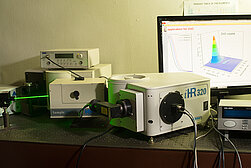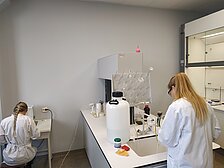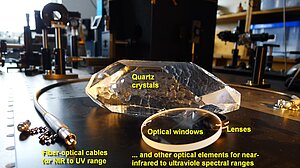
The Optical Materials laboratory specializes in luminescence and other optical phenomena research in various materials.
| Scientific degree | Name Surname | Position | Contact information |
|---|---|---|---|
| Ph.D. | Aleksejs Zolotarjovs | Head of the laboratory and Leading researcher | Aleksejs.Zolotarjovs |
| Dr.habil.phys. | Andrejs Siliņš | Leading researcher | Andrejs.Silins 67211405 |
| Dr.habil.phys. | Linards Skuja | Leading researcher | Linards.Skuja 67260756 |
| Dr.habil.phys. | Anatolijs Truhins | Leading researcher | Anatolijs.Truhins 67260756 |
| Dr.phys. | Virgīnija Vītola | Leading researcher | Virginija.Vitola |
| Ph.D. | Katrīna Laganovska | Leading researcher | Katrina.Laganovska |
| Dr.habil.phys. | Vilnis Dimza | Leading researcher | Vilnis.Dimza |
| Dr.phys. | Marija Dunce | Leading researcher | Marija.Dunce |
| Dr.habil.phys. | Andris Šternbergs | Leading researcher and Deputy Director for Science | Andris.Sternbergs |
| Dr.phys. | Ēriks Birks | Leading researcher and Project Manager | Eriks.Birks |
| Dr.phys. | Māris Kundziņš | Researcher | Maris.Kundzins |
| Ph.D. | Annamarija Trausa | Researcher | Annamarija.Trausa |
| Kristaps Saršūns | Guest Researcher | Kristaps.Sarsuns | |
| Ph.D. | Andrei Leonidovitch Kholkine | Research Consultant | Andrei.Kholkine |
| Mg. | Madara Leimane | Research Assistant | Madara.Leimane |
| Mg. | Ernests Einbergs | Research Assistant | Ernests.Einbergs |
| Miļena Dile | Research Assistant | Milena.Dile | |
| Gatis Tunēns | Research Assistant | Gatis.Tunens | |
| Arturs Atvars | Research Assistant | Arturs.Atvars | |
| Madara Kļave | Laboratory Assistant | Madara.Klave | |
| Katrīna Križmane | Laboratory Assistant | Katrina.Krizmane | |
| Gusts Agafonovs | Laboratory Assistant | Gusts.Agafonovs | |
| Kristaps Grava | Laboratory Assistant | Kristaps.Grava | |
| Anna Kalvāne | Laboratory Assistant | Anna.Kalvane | |
| Sergejs Kudinovs | Laboratory Assistant | Sergejs.Kudinovs | |
| Māris Līviņš | Laboratory Assistant | Maris.Livins | |
| Modris Logins | Laboratory Assistant | Modris.Logins | |
| Ligita Ostrovska | Laboratory Assistant | Ligita.Ostrovska | |
| Līva Krūza | Laboratory Assistant | Liva.Kruza | |
| Anna Gude | Laboratory Assistant | Anna.Gude |
Various oxides (ZrO2, HfO2, ZnO, SrAl2O4 etc.) doped with rare earth (RE) ions are studied. Optical properties are of main interest; however, laboratory staff is trained to perform other tasks: electron microscopy (SEM, TEM), sample preparation (Plasma Electrolytic Oxidation (PEO), various synthesis methods in a well-equipped chemical lab), as well as other material characterization (EDX, XRF, XRD).
Luminescence properties of ZnO in its various forms (monocrystals, nanopowders, ceramics and coatings) are studied. PEO coating research as well as dopant implementation development with the aim to improve and functionalize optical properties of coating. New PEO structures are produced with their characteristic properties, technologies for practical application of such coatings are developed.
Up-conversion luminescence studies are performed on RE doped ZrO2 and various ceramics.
Thermostimulated luminescence (TSL) methods are developed and applied. Unique developed setup allows the measurement of spectral distribution dependence on temperature. Various heating regimes allow defining the thermal activation energies of traps.
One of the general research fields of the laboratory is also studies of the influence of the amorphous state on the optical, electrical and chemical properties of solid materials.
The main research objects are: (1) silicon dioxide (SiO2) in its multiple crystalline, glassy and amorphous forms, (2) Various amorphous oxide materials related to SiO2, such as germanosilicate glasses and multicomponent silicate glasses. These materials are studied in bulk (monocrystals, polycrystals, glasses) , thin film, fiber and nanoparticle forms.
Silicon dioxide is selected as one of the main research object due to two aspects:
1) Fundamental aspect. Silicon dioxide is one of the few existing simple compounds, which exists both in crystalline and glassy states. This property allows to elucidate the effects of amorphous disorder on optical, electric and other properties of the material.
2) Application-related aspect. Silicon dioxide has a number of outstanding properties, which make it one of the presently most widely used materials in optics, photonics and microelectronics. It is the material of choice for low-loss optical communication fibers and for a plethora of specialty-fibers, for example, fibers for high power laser transmission in medicine or material processing, UV-transmitting fibers for analytical optical instrumentation, radiation-tough fibers for nuclear and space environments, fiber Bragg gratings for information processing and sensors, photonic fibers. High purity SiO2 glass is used in the vast majority of UV bulk optical elements (lenses, prisms, windows). SiO2 films on silicon serve as passivating, masking and dielectric layers in the Si-based microelectronics. Crystalline SiO2 in α-quartz form is used as a resonator in virtually any electronic timekeeping device.
Additional directions of research related to SiO2 in the laboratory are the following:
- The studies of optically active point defects in crystalline and glassy SiO2. Silicon dioxide is distinguished by an excellent optical transmissivity in the spectral range from the near infrared (1300nm) up to vacuum UV region (that is why it is No 1 in optical fibers). However, its optical properties are degraded by “point defects” – local deviations from the ideal interconnectivity between Si and O atoms in SiO2 network. Understanding of their structure, optical properties and formation processes is essential for many applications.
- Spectroscopic studies of SiO2 crystalline polymorphs. At the room temperature and at normal pressure SiO2 can exist in various polymorphic forms: stable form - α-quartz and metastable forms (α-tridymite, α-cristobalite, coesite, stishovite). It is usually assumed that the closest crystalline counterpart of glassy SiO2 is α-quartz. However, it is considered that in small local regions of amorphous SiO2, in particular, around point defects, there may exist structures, bearing resemblance to other crystalline polymorphs of SiO2.
- Studies of doped SiO2 and multicomponent SiO2-related glasses. SiO2 is often doped to obtain the necessary properties, for example, by Ge to increase the refraction coefficient in fiber waveguides and to create fiber optic Bragg gratings, by fluorine to decrease the refraction index or to increase the vacuum-UV transmission, or by rare earth ions to create fiber lasers.
- tudies of interstitial molecules in SiO2. Amorphous SiO2 and some crystalline forms of SiO2 (zeolites) have nanosized interstitial spaces in their structure, which can accommodate small molecules. They can be introduced by diffusion (e.g., H2) or created internally by photochemical reactions (O2), or introduced during synthesis (Cl2). Their presence significantly affects the optical properties of SiO2 and their studies are of direct practical interest.
- Studies of SiO2 nanoparticles and photochemical properties on surfaces of SiO2. Different SiO2 related nanoparticles and core-shell structures are widely studied for biological applications, e.g., drug transport, photodynamic therapy, sensors. Compared to the crystalline polymorphs, amorphous SiO2 is characterized by large interstitial spaces, which can be considered as internal surfaces. Defects on these internal surfaces bear many similarities to defects on outer surfaces of SiO2, which affect the photo- chemical processes in applications involving SiO2 nanoparticles.
The studies in the laboratory are performed mainly by spectroscopic methods. The available equipment allows using optical absorption and luminescence spectroscopy, time-resolved and luminescence kinetics spectroscopy, infrared absorption, Raman scattering (at several wavelengths) and vacuum-ultraviolet spectroscopy. Low temperature (down to 14K) measurements are available. In cooperation with other laboratories and partners many other investigation methods (e.g., XRD, XRF, EPR...) are available.
Bohacek, P., Krasnikov, A., Nikl, M., Zazubovich, S., Zolotarjovs, A. On low-temperature luminescence quenching in Gd3(Ga,Al)5O12:Ce crystals (2019) Optical Materials, 95, art. no. 109252, . DOI: 10.1016/j.optmat.2019.109252
Cipa, J., Zarins, A., Supe, A., Kizane, G., Zolotarjovs, A., Baumane, L., Trinkler, L., Leys, O., Knitter, R. X-ray induced defects in advanced lithium orthosilicate pebbles with additions of lithium metatitanate (2019) Fusion Engineering and Design, 143, pp. 10-15. DOI: 10.1016/j.fusengdes.2019.03.096
Zolotarjovs, A., Smits, K., Laganovska, K., Bite, I., Grigorjeva, L., Auzins, K., Millers, D., Skuja, L. Thermostimulated luminescence of plasma electrolytic oxidation coatings on 6082 aluminium surface (2019) Radiation Measurements, 124, pp. 29-34. DOI: 10.1016/j.radmeas.2019.02.020
Grigorjeva, L., Grube, J., Bite, I., Zolotarjovs, A., Smits, K., Millers, D., Rodnyi, P., Chernenko, K. Sub-nanosecond excitonic luminescence in ZnO:In nanocrystals (2019) Radiation Measurements, 123, pp. 69-73. DOI: 10.1016/j.radmeas.2019.02.016
Korzhik, M., Alenkov, V., Buzanov, O., Fedorov, A., Dosovitskiy, G., Grigorjeva, L., Mechinsky, V., Sokolov, P., Tratsiak, Y., Zolotarjovs, A., Dormenev, V., Dosovitskiy, A., Agrawal, D., Anniyev, T., Vasilyev, M., Khabashesku, V. Nanoengineered Gd 3 Al 2 Ga 3 O 12 Scintillation Materials with Disordered Garnet Structure for Novel Detectors of Ionizing Radiation (2019) Crystal Research and Technology, 54 (4), art. no. 1800172, . DOI: 10.1002/crat.201800172
Grigorjeva, L., Zolotarjovs, A., Bite, I., Grube, J., Millers, D. Electronic processes in doped ZnO nanopowders (2019) IOP Conference Series: Materials Science and Engineering, 503 (1), art. no. 012017, . DOI: 10.1088/1757-899X/503/1/012017
Vitola, V., Millers, D., Smits, K., Bite, I., Zolotarjovs, A. The search for defects in undoped SrAl2O4 material (2019) Optical Materials, 87, pp. 48-52. DOI: 10.1016/j.optmat.2018.06.004
Vitola, V., Millers, D., Bite, I., Smits, K., Spustaka, A. Recent progress in understanding the persistent luminescence in SrAl2O4:Eu,Dy (2019) Materials Science and Technology (United Kingdom), 35 (14), pp. 1661-1677. DOI: 10.1080/02670836.2019.1649802
Rucins, M., Dimitrijevs, P., Pajuste, K., Petrichenko, O., Jackevica, L., Gulbe, A., Kibilda, S., Smits, K., Plotniece, M., Tirzite, D., Pajuste, K., Sobolev, A., Liepins, J., Domracheva, I., Plotniece, A. Contribution of molecular structure to self-assembling and biological properties of bifunctional lipid-like 4-(N-alkylpyridinium)-1,4-Dihydropyridines (2019) Pharmaceutics, 11 (3), art. no. 115, .DOI: 10.3390/pharmaceutics11030115
Skuja, L., Ollier, N., Kajihara, K., Smits, K. Creation of glass-characteristic point defects in crystalline SiO2 by 2.5 MeV electrons and by fast neutrons (2019) Journal of Non-Crystalline Solids, 505, pp. 252-259. DOI: 10.1016/j.jnoncrysol.2018.11.014
Ristić, I., Miletić, A., Vukić, N., Marinović-Cincović, M., Smits, K., Cakić, S., Pilić, B. Characterization of electrospun poly(lactide) composites containing multiwalled carbon nanotubes (2019) Journal of Thermoplastic Composite Materials, . DOI: 10.1177/0892705719857780
Trukhin, A.N. Luminescence of natural α-quartz crystal with aluminum, alkali and noble ions impurities (2019) Journal of Luminescence, 214, art. no. 116602, . DOI: 10.1016/j.jlumin.2019.116602
Trukhin, A.N. Luminescence of localized states in oxidized and fluorinated silica glass (2019) Journal of Non-Crystalline Solids, 521, art. no. 119525, . DOI: 10.1016/j.jnoncrysol.2019
Trinkler, L., Trukhin, A., Cipa, J., Berzina, B., Korsaks, V., Chou, M.M.C., Li, C.-A. Spectral and kinetic characteristics of pyroelectric luminescence in LiGaO2 (2019) Optical Materials, 94, pp. 15-20. DOI: 10.1016/j.optmat.2019.05.014
Trukhin, A., Trinkler, L. Photoconductivity & photoelectron emission of LiGaO2 crystal excited in intrinsic absorption range (2019) Optical Materials, 93, pp. 11-14. DOI: 10.1016/j.optmat.2019.05.005
Trukhin, A.N. Photoelectric response of localized states in silica glass (2019) Journal of Non-Crystalline Solids, 511, pp. 161-165. DOI: 10.1016/j.jnoncrysol.2019.02.002
Trukhin, A., Antuzevics, A. Photoluminescence and Electron Spin Resonance of Silicon Dioxide Crystal with Rutile Structure (Stishovite) (2019) Physica Status Solidi (A) Applications and Materials Science, 216 (3), art. no. 1800457, DOI: 10.1002/pssa.201800457
Bite, I., Krieke, G., Zolotarjovs, A., Laganovska, K., Liepina, V., Smits, K., Auzins, K., Grigorjeva, L., Millers, D., Skuja, L. Novel method of phosphorescent strontium aluminate coating preparation on aluminum (2018) Materials and Design, 160, pp. 794-802. DOI: 10.1016/j.matdes.2018.10.021
Joost, U., Šutka, A., Oja, M., Smits, K., Döbelin, N., Loot, A., Järvekülg, M., Hirsimäki, M., Valden, M., Nõmmiste, E. Reversible Photodoping of TiO2 Nanoparticles for Photochromic Applications (2018) Chemistry of Materials, 30 (24), pp. 8968-8974. DOI: 10.1021/acs.chemmater.8b04813
Labrador-Páez, L., Jovanović, D.J., Marqués, M.I., Smits, K., Dolić, S.D., Jaque, F., Stanley, H.E., Dramićanin, M.D., García-Solé, J., Haro-González, P., Jaque, D. Unveiling Molecular Changes in Water by Small Luminescent Nanoparticles (2017) Small, 13 (30), art. no. 1700968, . DOI: 10.1002/smll.201700968
Skuja, L., Kajihara, K., Smits, K., Silins, A., Hosono, H. Luminescence and Raman Detection of Molecular Cl2 and ClClO Molecules in Amorphous SiO2 Matrix (2017) Journal of Physical Chemistry C, 121 (9), pp. 5261-5266. DOI: 10.1021/acs.jpcc.6b13095
Polyakov, B., Kuzmin, A., Smits, K., Zideluns, J., Butanovs, E., Butikova, J., Vlassov, S., Piskunov, S., Zhukovskii, Y.F. Unexpected epitaxial growth of a few WS2 Layers on {1100} facets of ZnO nanowires (2016) Journal of Physical Chemistry C, 120 (38), pp. 21451-21459. DOI: 10.1021/acs.jpcc.6b06139
Kajihara, K., Skuja, L., Hosono, H. Diffusion and reactions of photoinduced interstitial oxygen atoms in amorphous SiO2 impregnated with 18O-labeled interstitial oxygen molecules (2014) Journal of Physical Chemistry C, 118 (8), pp. 4282-4286. DOI: 10.1021/jp412606a
Šutka, A., Käämbre, T., Joost, U., Kooser, K., Kook, M., Duarte, R.F., Kisand, V., Maiorov, M., Döbelin, N., Smits, K. Solvothermal synthesis derived Co-Ga codoped ZnO diluted magnetic degenerated semiconductor nanocrystals (2018) Journal of Alloys and Compounds, 763, pp. 164-172. DOI: 10.1016/j.jallcom.2018.05.036
Šutka, A., Vanags, M., Joost, U., Šmits, K., Ruža, J., Ločs, J., Kleperis, J., Juhna, T. Aqueous synthesis of Z-scheme photocatalyst powders and thin-film photoanodes from earth abundant elements (2018) Journal of Environmental Chemical Engineering, 6 (2), pp. 2606-2615. DOI: 10.1016/j.jece.2018.04.003
Šutka, A., Döbelin, N., Joost, U., Smits, K., Kisand, V., Maiorov, M., Kooser, K., Kook, M., Duarte, R.F., Käämbre, T. Facile synthesis of magnetically separable CoFe2O4/Ag2O/Ag2CO3 nanoheterostructures with high photocatalytic performance under visible light and enhanced stability against photodegradation (2017) Journal of Environmental Chemical Engineering, 5 (4), pp. 3455-3462. DOI: 10.1016/j.jece.2017.07.009
Grigorjeva, L., Millers, D., Smits, K., Zolotarjovs, A. Gas sensitive luminescence of ZnO coatings obtained by plazma electrolytic oxidation (2015) Sensors and Actuators, A: Physical, 234, pp. 290-293. DOI: 10.1016/j.sna.2015.09.018

